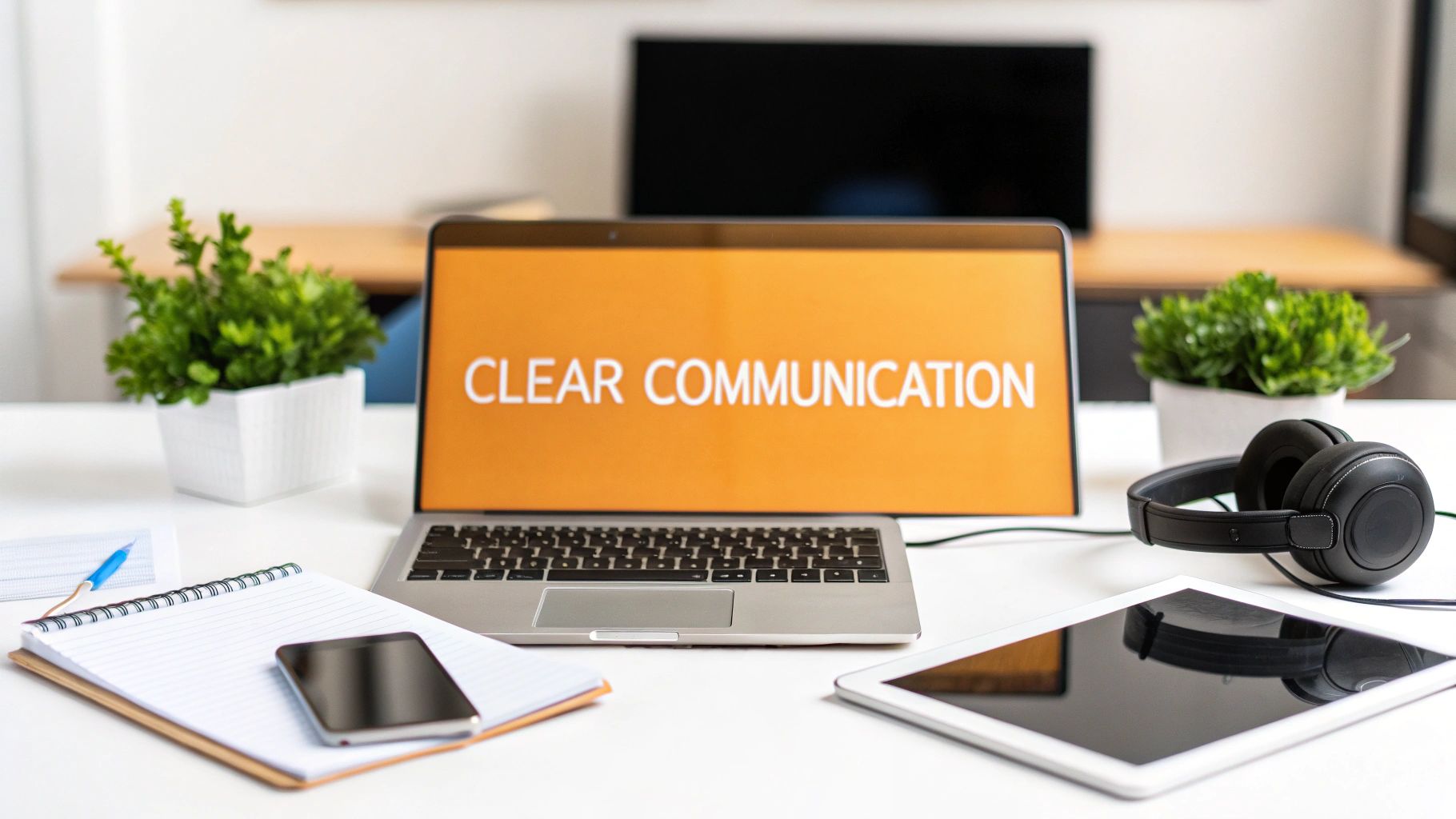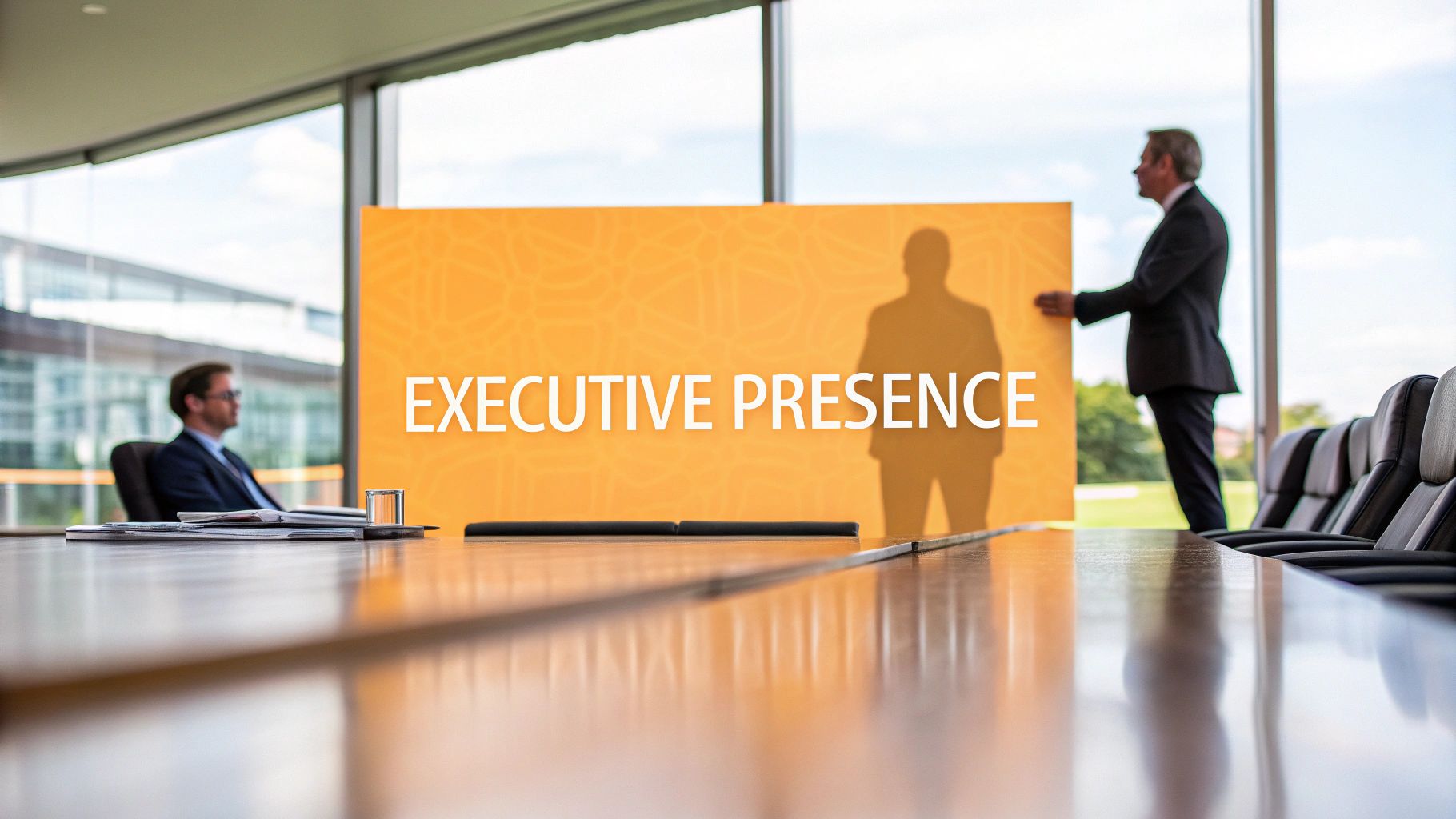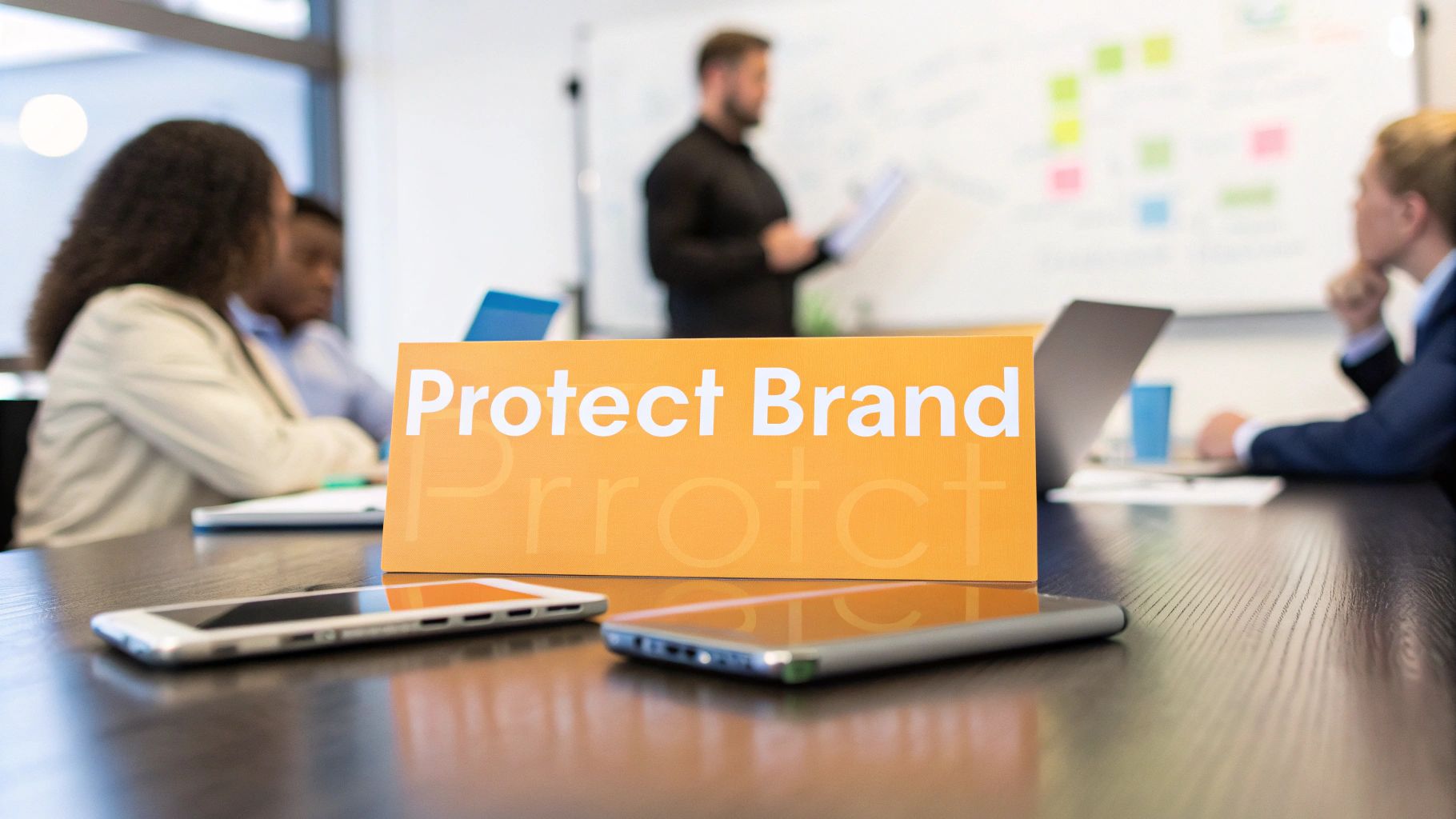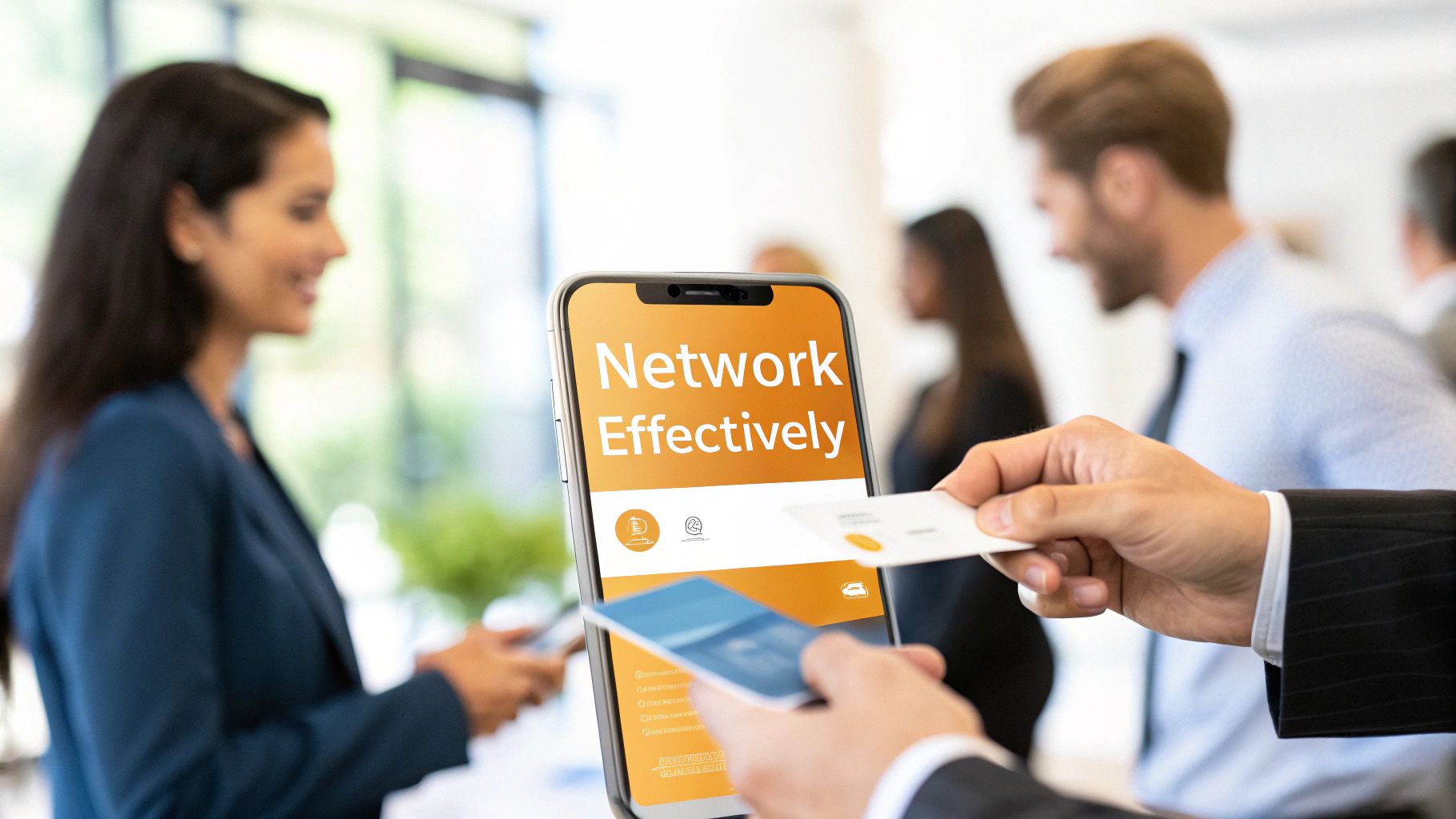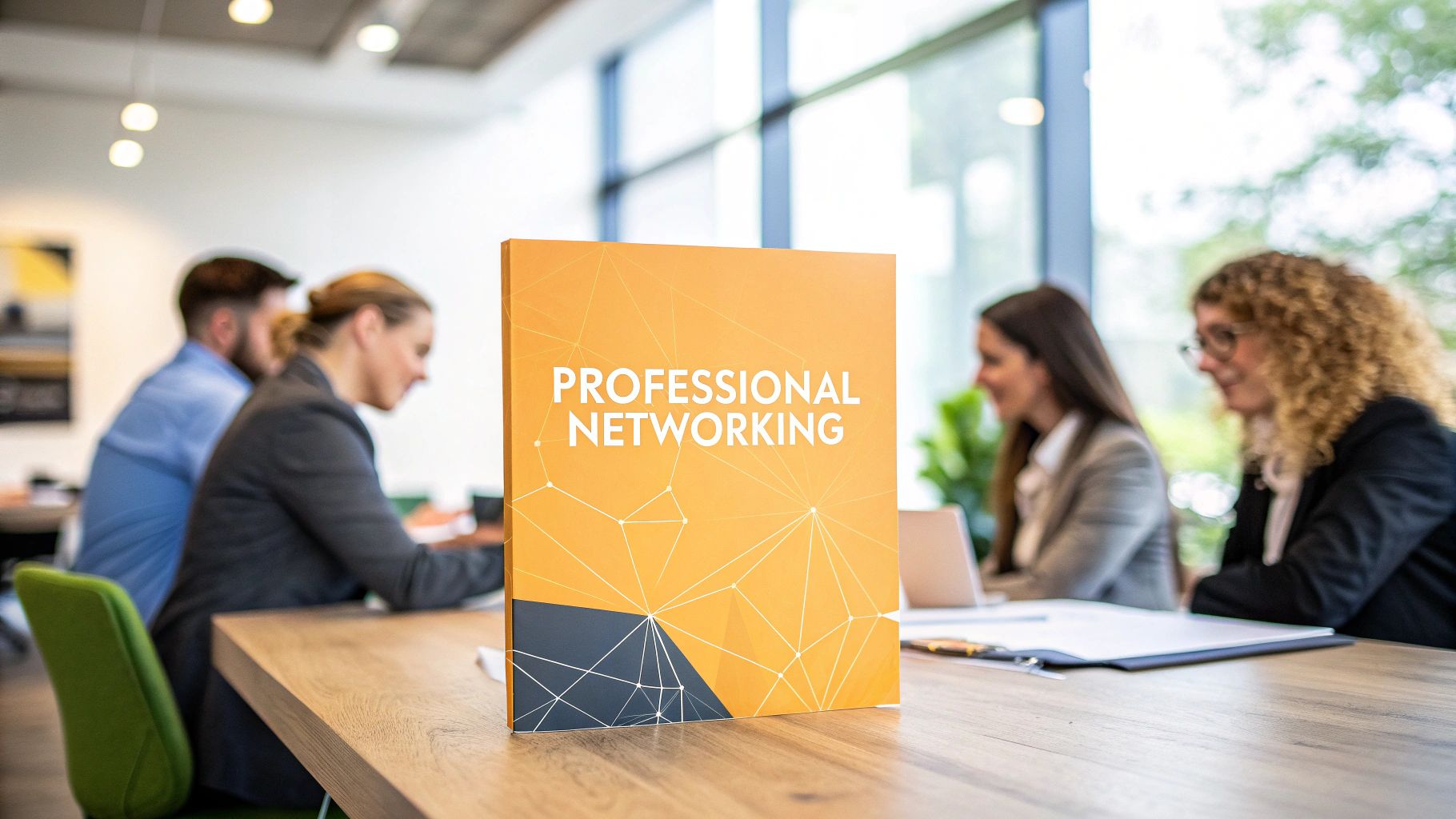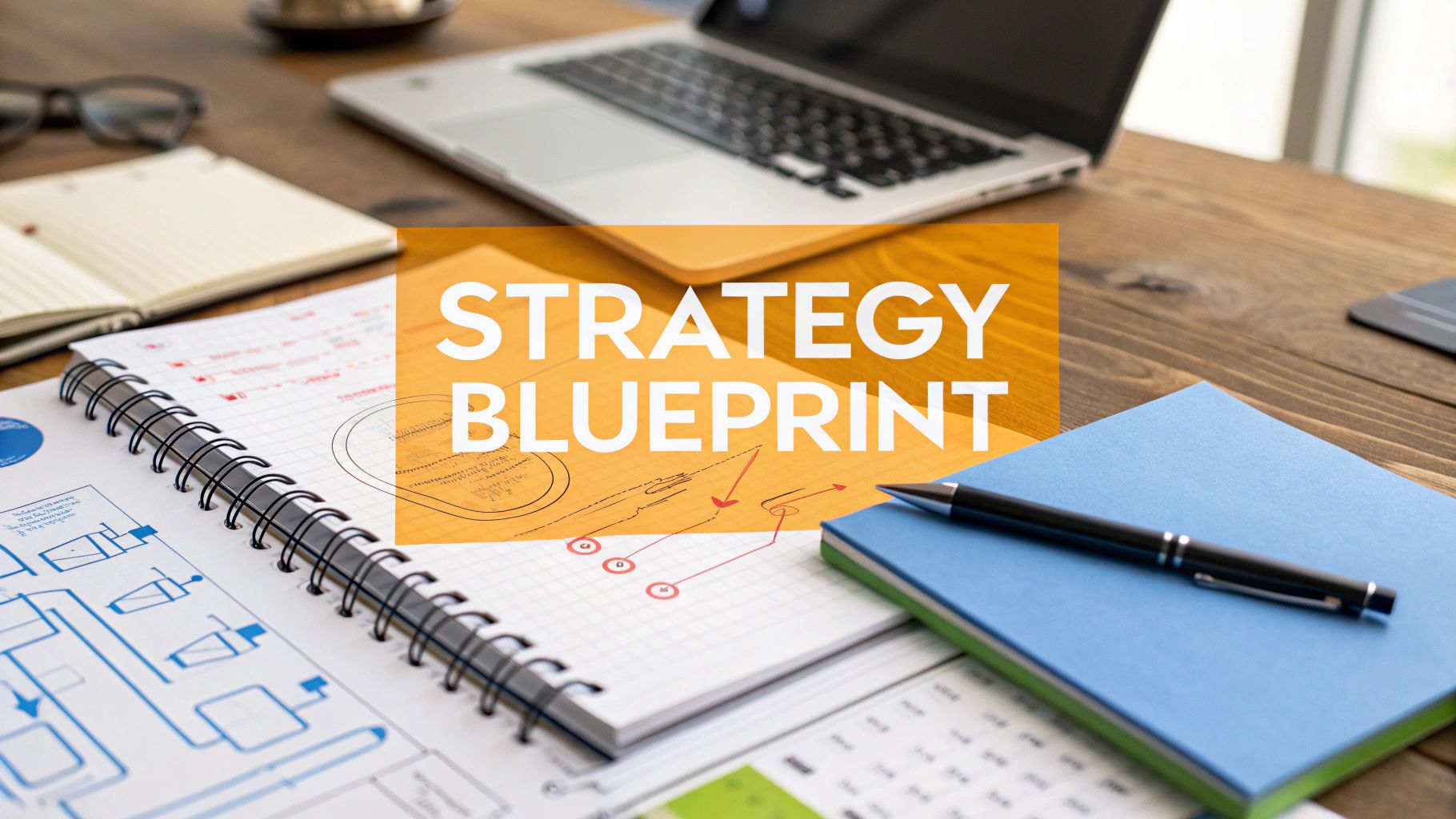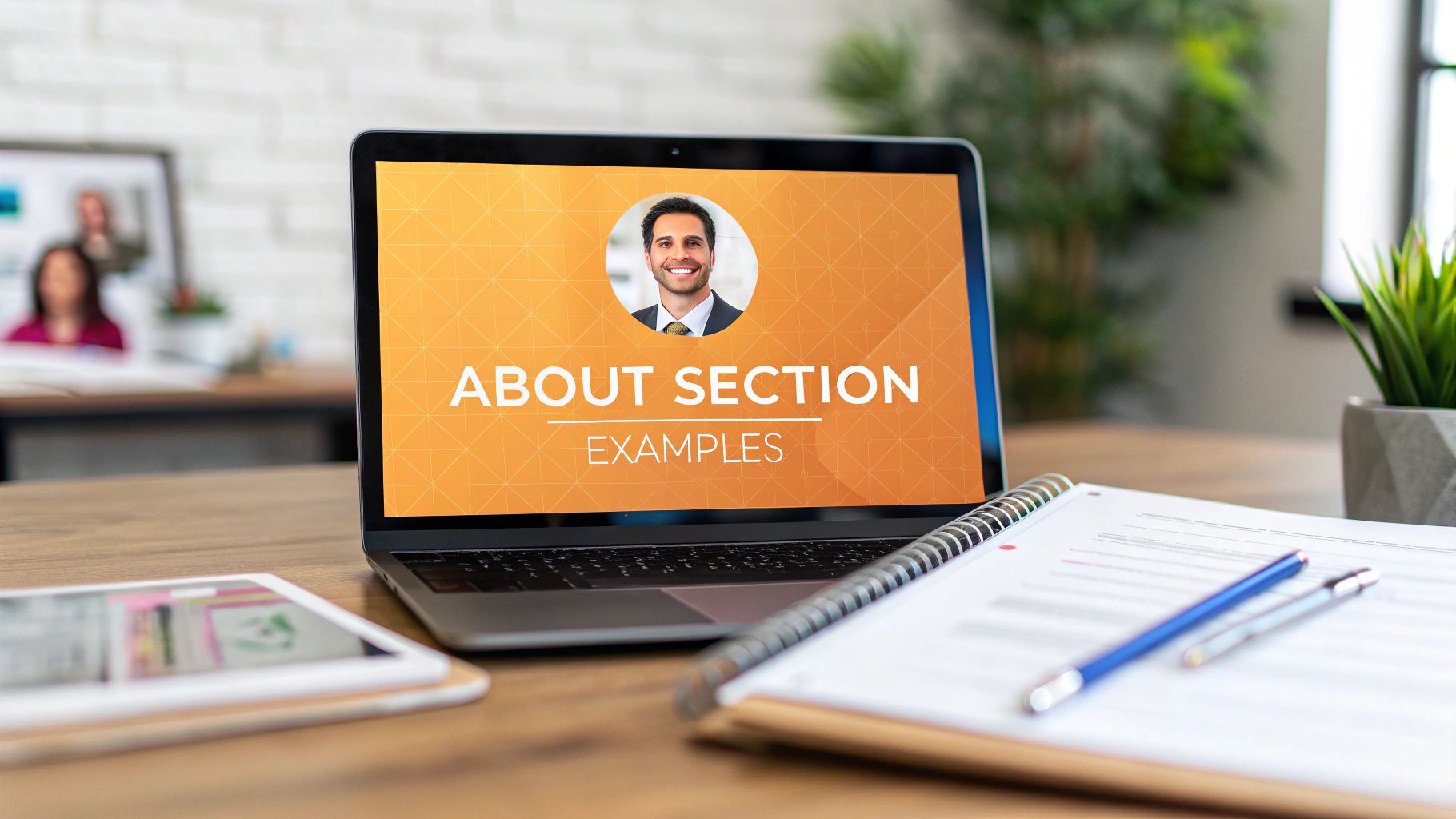Workplace disagreements are inevitable, but they don't have to be destructive. When handled correctly, conflict can be a powerful catalyst for innovation, stronger team bonds, and deeper understanding. But navigating these tricky situations requires more than just good intentions. It demands a toolkit of proven conflict resolution strategies that turn friction into forward momentum. In this guide, we'll move beyond generic advice and dive into 10 distinct, actionable approaches tailored for professional settings.
We'll explore everything from formal processes like arbitration and mediation to foundational skills like assertive communication, providing practical steps and real-world scenarios for each. Managing interpersonal dynamics is a core part of professional growth. For a deeper dive into this, you might find valuable insights into navigating workplace relationships and stress.
This list is designed to equip you with the confidence and skill to manage professional disputes effectively. You'll learn not just what each strategy is, but how to implement it when the stakes are high. Get ready to transform tense moments into opportunities for positive, lasting change.
1. Negotiation
Negotiation is the classic go-to for a reason: it's a structured conversation aimed at finding a solution that works for everyone. Instead of one side “winning,” the goal is to reach a mutually beneficial agreement through dialogue, compromise, and a bit of creative problem-solving. It's one of the most direct and empowering conflict resolution strategies available.
This approach works best when both parties are willing to communicate openly and have a genuine desire to resolve the issue. Think of it as a collaborative effort, not a battle. For example, instead of a project manager and a department head arguing over a deadline (their positions), they could negotiate to uncover the underlying needs (their interests). The manager needs to show progress, while the department head needs to ensure quality work without burning out their team.
How to Make it Work:
- Prepare, Prepare, Prepare: Don't walk in cold. Understand your goals, your non-negotiables, and what the other party likely wants.
- Focus on Interests, Not Positions: A position is what someone wants ("I need this report by Friday"). An interest is why they want it ("I need the data for a board meeting on Monday"). Targeting the "why" opens up more solutions.
- Aim for a Win-Win: Look for common ground. What can you offer that is low-cost for you but high-value for them?
Key Insight: Successful negotiation isn't about getting your way; it's about redefining "your way" to include the other party's essential needs.
This strategy is particularly effective in high-stakes professional situations. For practical application, especially during difficult career transitions, consider resources on negotiating a severance package to see these principles in action.
2. Mediation
When direct negotiation stalls or emotions run too high, bringing in a neutral third party can be a game-changer. Mediation is a facilitated process where a trained, impartial mediator helps disputants communicate effectively and find their own solution. Unlike a judge or arbitrator, a mediator doesn’t impose a decision; they guide the conversation, clarify issues, and help the parties find common ground.
This approach is invaluable when the relationship between parties needs to be preserved, like between co-founders or long-term colleagues. Imagine two department heads in a stalemate over budget allocation. A mediator can help them move past their entrenched positions, explore the underlying interests of each department, and collaboratively design a budget that meets both their core needs, preventing a breakdown in communication that could harm the entire company.

How to Make it Work:
- Choose a Neutral Guide: Select a qualified mediator who both parties trust. Their impartiality is crucial for creating a safe space for open dialogue.
- Prepare Your Perspective: Walk into the session with a clear understanding of your needs, interests, and what you're willing to compromise on.
- Listen to Understand: The mediator's job is to ensure everyone is heard. Focus on understanding the other person's viewpoint, not just on preparing your rebuttal.
Key Insight: Mediation isn't about having a referee decide who's right. It's about having a facilitator create an environment where you can both discover the right solution together.
Mediation is one of the most effective conflict resolution strategies for defusing high-tension situations before they escalate into a full-blown crisis. Understanding its principles can be a core part of effective crisis communication planning, ensuring disagreements are managed constructively.
3. Arbitration
Arbitration is a more formal, structured process where a neutral third party, known as an arbitrator, steps in to make a final, binding decision. Think of it as a private court proceeding. Both sides present their evidence and arguments, and the arbitrator acts like a judge, rendering a verdict that is legally enforceable. It’s a powerful conflict resolution strategy when direct negotiation or mediation has failed.
This approach is common in business contracts, especially for international commercial disputes, employment agreements, or construction projects where a definitive outcome is needed. For example, if two companies have a contractual disagreement over a project's scope, they might enter arbitration to have an industry expert decide the outcome, avoiding a lengthy and public court battle. The decision is typically confidential and final.
How to Make it Work:
- Understand the Clause: Before signing any contract, carefully review the arbitration clause. Know what you’re agreeing to, as it often means waiving your right to sue in court.
- Choose the Right Arbitrator: The arbitrator's expertise is crucial. Select someone with deep knowledge of your specific industry or the legal issues at hand. Organizations like the American Arbitration Association (AAA) can help.
- Prepare a Strong Case: Just like a court case, success depends on solid evidence. Gather all relevant documents, emails, and witness testimonies to build a comprehensive and persuasive argument.
Key Insight: Arbitration trades the flexibility of negotiation for the certainty of a final decision, making it ideal for high-stakes conflicts where a resolution is non-negotiable.
4. Collaborative Problem-Solving
Collaborative problem-solving transforms a conflict from an adversarial "me vs. you" standoff into a cooperative "us vs. the problem" challenge. This approach involves all parties working together as a team to dig deep, uncover the core needs driving the conflict, and co-create an innovative solution that satisfies everyone involved. It’s less about compromise and more about finding a third, often better, way forward.
This method thrives in environments where ongoing relationships matter, such as within a project team or between departments. For instance, when the marketing and sales teams clash over lead quality, they can use collaborative problem-solving to jointly define what a "qualified lead" is, create a shared scoring system, and establish a feedback loop. This solves the immediate issue and strengthens their working relationship.

How to Make it Work:
- Define the Problem Together: Don't start with solutions. Your first step is to agree on a single, shared definition of the problem you are trying to solve.
- Brainstorm Without Judgment: Create a safe space where all ideas are welcome, no matter how unconventional. Focus on generating a wide range of options before evaluating any of them.
- Evaluate Against Mutual Interests: Once you have a list of potential solutions, measure each one against the core interests and needs of every party involved, not their initial positions.
Key Insight: Collaborative problem-solving assumes that a better solution exists than what either party originally envisioned, and that it can only be found through joint effort.
This strategy is highly effective for complex, systemic issues where simple compromises won't last. Success in this area relies heavily on strong interpersonal skills, a core component of effective relationship building at work.
5. Active Listening
Active listening is more than just hearing words; it's a communication technique where you fully concentrate to understand the speaker's message, emotions, and underlying needs. Instead of formulating a rebuttal, you focus entirely on the other person, creating an environment of safety and respect. It is one of the most foundational conflict resolution strategies because it validates the other person's perspective before a solution is even discussed.
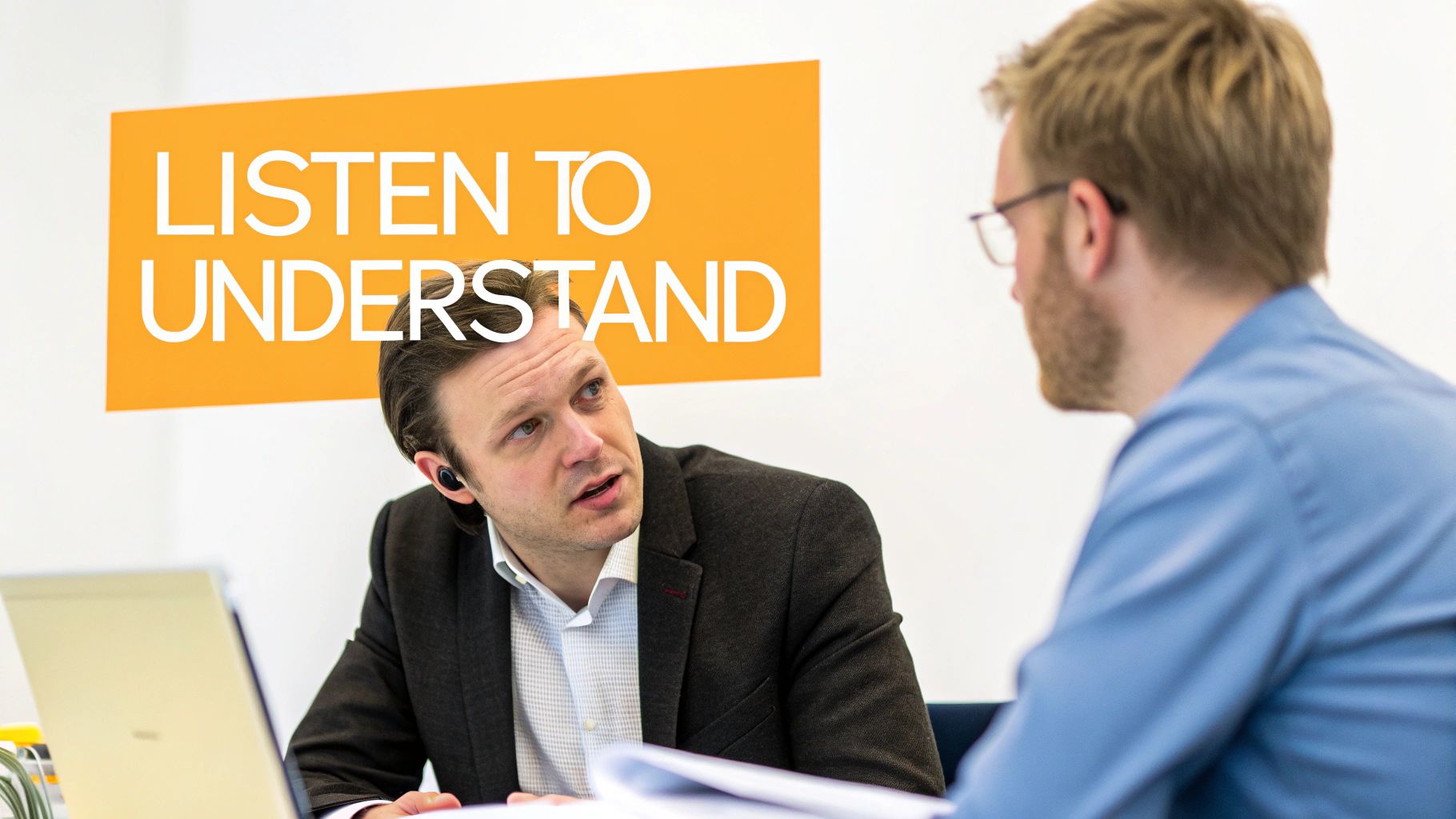
This approach is crucial when emotions are high and misunderstandings are likely. Think of an HR manager handling an employee grievance. Rather than jumping to conclusions, the manager listens intently, paraphrases the employee's concerns ("So, it sounds like you felt your contributions were overlooked during the project meeting, is that right?"), and validates their feelings. This de-escalates tension and builds the trust needed to find a real solution.
How to Make it Work:
- Silence Your Inner Voice: Consciously stop planning your response while the other person is talking. Your only goal is to understand.
- Paraphrase and Clarify: Repeat back what you heard in your own words ("What I'm hearing is...") to ensure you've understood correctly and show you're engaged.
- Listen for Feelings, Not Just Facts: Pay attention to tone of voice, body language, and the emotions behind the words. Acknowledge them by saying things like, "That sounds incredibly frustrating."
Key Insight: People won't be open to your solution until they feel truly heard and understood. Active listening is the key that unlocks that door.
This strategy is a cornerstone of effective professional dialogue. For a deeper dive into its role, explore these best practices for business communication to see how listening underpins success.
6. Nonviolent Communication (NVC)
Nonviolent Communication (NVC) is a powerful framework that reframes conflict from a battle of right versus wrong to a shared exploration of human needs. Developed by Marshall Rosenberg, this approach emphasizes expressing oneself clearly and empathetically, steering conversations away from blame and toward compassionate connection. It is one of the most transformative conflict resolution strategies because it focuses on the universal needs behind our actions.
This technique is especially effective when emotions are high and misunderstandings are common, such as in tense team meetings or during feedback sessions. Imagine a manager is frustrated with a team member's missed deadlines. Instead of saying, "You're always late and unreliable" (judgment), they could use NVC to say, "When I see the project report isn't submitted by the deadline (observation), I feel worried (feeling) because I need assurance that we can meet our commitments to the client (need). Would you be willing to discuss how we can get back on track? (request)."
How to Make it Work:
- Follow the Four Steps: Practice the Observation-Feeling-Need-Request model. State a neutral observation, express the feeling it evokes in you, identify the universal need behind that feeling, and make a clear, actionable request.
- Speak from the "I": Frame your statements around your own experience ("I feel...") rather than accusing the other person ("You made me feel..."). This prevents defensiveness and keeps the dialogue open.
- Listen with Empathy: When others speak, try to hear the feelings and needs behind their words, even if they aren't using the NVC framework. This helps you respond to their core message, not just their surface-level complaints.
Key Insight: NVC teaches that all conflict arises from unmet needs. By focusing on identifying and honoring everyone's needs, you can find solutions that build connection instead of resentment.
This strategy is incredibly versatile, useful in everything from corporate team training to family disputes. For those interested in a deep dive, the Center for Nonviolent Communication offers a wealth of resources to master this approach.
7. Conflict Avoidance
Conflict avoidance is a passive approach where you intentionally step away from a dispute. It means choosing not to engage, either by withdrawing from the situation, ignoring the issue, or suppressing your feelings. While often seen as a negative, when used strategically, it's one of the most practical conflict resolution strategies for de-escalating a tense situation.
This tactic is best used as a temporary tool, not a permanent solution. For instance, if a team meeting gets heated over a project’s direction, taking a 15-minute break is a form of avoidance. It allows emotions to cool, giving everyone a chance to return to the discussion with a clearer perspective. It’s about postponing the conflict, not pretending it doesn't exist.
How to Make it Work:
- Use it for Trivial Issues: If the issue is minor and not worth the energy, letting it go can be the most efficient choice.
- Set a Timeline to Revisit: When avoiding a serious issue, agree on a specific time to address it later. Say, "This is getting tense. Let's pause and continue this tomorrow at 10 AM."
- Assess the Risks: Understand that chronic avoidance can cause resentment and let problems fester. Use this strategy consciously and sparingly.
Key Insight: Strategic avoidance isn't about running from conflict; it's about choosing the right time and emotional state to confront it effectively.
8. Assertive Communication
Assertive communication is a direct and honest style of expressing your needs and feelings while respecting the rights of others. It’s the healthy middle ground between being passive (letting issues slide) and aggressive (attacking the other person). This strategy is about standing up for yourself clearly and respectfully, making it one of the most effective personal conflict resolution strategies.
This approach is crucial when you need to advocate for yourself without damaging relationships. Imagine a colleague consistently missing deadlines, which impacts your work. Instead of silently fuming (passive) or accusing them of being lazy (aggressive), you could assertively say, “When deadlines are missed, I have to rush my part of the project, which causes stress.” You’re stating the problem and its impact without blame.
How to Make it Work:
- Use 'I' Statements: Frame the issue around its impact on you. “I feel frustrated when…” is more constructive than “You always…”
- Be Clear and Specific: Don’t hint at the problem. Clearly state what you need. For example, “I need your report by Thursday at 3 PM to complete my section.”
- Maintain Calm Body Language: Keep your tone of voice even, maintain eye contact, and have a relaxed posture. Your non-verbal cues should match your assertive words.
Key Insight: Assertiveness isn't about winning an argument; it's about expressing your truth clearly and creating a space where a resolution can be found together.
This skill is fundamental in both professional and personal contexts. For a deeper dive into the psychological underpinnings, resources from the Albert Ellis Institute on Rational Emotive Behavior Therapy offer valuable context on building these communication habits.
9. Compromise
Compromise is often seen as the quintessential conflict resolution strategy where each party agrees to give up something to find a middle ground. Instead of a winner-takes-all outcome, both sides make concessions to reach a mutually acceptable agreement. It’s a practical approach that acknowledges that in many conflicts, a perfect solution for one side is impossible without causing significant loss for the other.
This strategy works best when the issue is divisible and both parties have some flexibility. A classic example is a salary negotiation where a candidate asks for $80,000 and the company offers $70,000. A compromise might lead them to settle at $75,000. Similarly, two departments fighting over a limited budget might agree to split the remaining funds 50/50 instead of one getting everything. It’s a solution focused on pragmatism and moving forward.
How to Make it Work:
- Know Your Priorities: Before you start, clearly distinguish your "must-haves" from your "nice-to-haves." This helps you know where you can be flexible.
- Make a Reasonable First Offer: Starting from an extreme position can make the other party less willing to engage. A realistic opening sets a collaborative tone.
- Propose Creative Concessions: Don't just split everything down the middle. Offer to concede on an issue that is low-priority for you but high-priority for them, and ask for the same in return.
Key Insight: True compromise isn't about losing; it's about jointly creating a viable path forward when an ideal individual outcome isn't on the table.
10. Restorative Justice
Restorative justice shifts the focus from punishment to healing. This approach prioritizes repairing the harm caused by conflict and rebuilding relationships by bringing together those who were harmed, those responsible for the harm, and relevant community members. The goal isn't to assign blame but to understand the impact of actions and collaboratively create a plan for making things right. It’s a powerful tool for addressing deeper, more systemic issues within a team or organization.
This method works wonders in situations where a conflict has caused significant emotional or relational damage, like a bullying incident or a major project failure that fractured team trust. Instead of a formal HR complaint (which can be adversarial), a restorative circle allows everyone to share their perspective. The person who was harmed can explain the impact, while the person responsible can take accountability in a supported environment, leading to genuine reconciliation rather than just compliance.
How to Make it Work:
- Ensure Voluntary Participation: This process only works if all parties, especially the one who caused harm, are willing to engage honestly.
- Use a Trained Facilitator: A neutral, trauma-informed facilitator is crucial to create a safe space, guide the conversation, and prevent further harm.
- Focus on Impact and Needs: The conversation should center on the real-world impact of the actions and what the harmed party needs to feel whole again, not just on rules that were broken.
Key Insight: True resolution comes from addressing the human impact of a conflict, not just the procedural violation. Restorative justice rebuilds the trust that punishment often destroys.
This strategy is one of the most profound conflict resolution strategies for mending deep relational fractures. To see these principles applied in various settings, the International Institute for Restorative Practices offers extensive resources and training.
10-Strategy Conflict Resolution Comparison
| Method | Implementation 🔄 | Resources ⚡ | Expected outcomes 📊 | Ideal use cases 💡 | Key advantages ⭐ |
|---|---|---|---|---|---|
| Negotiation | Low–moderate; informal bilateral process dependent on party skills | Low cost; time varies with rounds of offers | Non-binding agreements; variable fairness; often preserves relationships | Business deals, salary talks, trade, labor discussions | Fast, flexible, cost‑effective; direct control over outcome |
| Mediation | Moderate; structured sessions guided by neutral facilitator | Low–moderate cost (mediator fees); shorter than litigation | Non‑binding agreements; improved communication; relationship preservation | Divorce, workplace disputes, community/confidential conflicts | Neutral facilitation reduces bias; confidential; fosters dialogue |
| Arbitration | High; formal procedures with rules resembling court | Moderate–high cost; legal prep and arbitrator fees | Binding, enforceable decision; limited appeal; faster than court | Commercial contracts, employment claims, international disputes | Finality and enforceability; expert decision‑maker; private process |
| Collaborative Problem‑Solving | High; joint facilitated workshops and iterative design | Moderate resource/time investment; facilitator and stakeholder commitment | Creative, durable solutions addressing root causes; stronger buy‑in | Organizational conflicts, inter‑departmental issues, stakeholder planning | Produces innovative, win‑win outcomes; builds lasting relationships |
| Active Listening | Low; individual technique requiring practice | Minimal monetary cost; time investment in conversations | Better understanding, de‑escalation, clarity; not always a standalone fix | Therapy, customer service, coaching, difficult personal talks | Builds trust quickly; reduces misunderstandings; immediate effect |
| Nonviolent Communication (NVC) | Moderate–high; structured four‑step practice needing repetition | Low monetary cost but significant practice/time to master | Increased empathy and reduced defensiveness; may slow process | Family disputes, emotional conflicts, workplace culture change | Deep mutual understanding; transforms blaming dynamics |
| Conflict Avoidance | Very low; passive withdrawal or postponement | Minimal immediate resources; potential high long‑term cost | Short‑term calm; long‑term unresolved issues, resentment risk | Trivial conflicts, cooling‑off periods, some cultural contexts | Prevents immediate escalation; temporary stress relief |
| Assertive Communication | Low–moderate; skill development for clear, respectful expression | Low cost; practice and feedback required | Clear boundaries and reduced misunderstandings; may invite pushback | Boundary setting, requests, workplace feedback, advocacy | Promotes clarity and respect; improves self‑advocacy |
| Compromise | Low–moderate; mutual concessions toward middle ground | Low time/cost; relatively quick to conclude | Agreement reached quickly; solution may be suboptimal for some | Moderate‑stakes disputes with time pressure or equal power | Fast, perceived as fair; preserves relationships |
| Restorative Justice | High; multi‑stakeholder dialogues and restoration planning | High time and skilled facilitation; community resources needed | Repair of harm, accountability, reduced recidivism; healing focus | Schools, community harm, victim‑offender mediation, reconciliation | Focuses on healing and accountability; strengthens community ties |
Choosing Your Strategy and Moving Forward
We've explored a powerful toolkit of ten distinct conflict resolution strategies, from the formal processes of arbitration to the empathetic framework of Nonviolent Communication. The real magic, however, isn't in knowing what they are, but in knowing when and how to use them. Think of these strategies not as a rigid set of instructions, but as different lenses through which to view and navigate disagreements.
A minor disagreement over project timelines might just need a straightforward compromise. A more complex, emotionally charged issue between two team members, on the other hand, could benefit immensely from the structured dialogue of mediation or the deep empathy of active listening. The key is to avoid a one-size-fits-all mentality. Your ability to accurately assess a situation and select the most appropriate tool is what will transform you from someone who simply deals with conflict to someone who resolves it effectively and constructively.
The Real Takeaway: It’s All About Flexibility
If you remember one thing from this guide, let it be this: the most successful conflict resolvers are agile. They don’t just stick to their favorite method. Instead, they tailor their approach to the specific people and problems involved.
Here’s a quick recap of the core idea:
- Low-Stakes Issues: For everyday friction, strategies like compromise, assertive communication, or even strategic conflict avoidance can be highly effective and efficient.
- Relationship-Focused Conflicts: When preserving the relationship is paramount, lean into collaborative problem-solving, active listening, and Nonviolent Communication. These build bridges rather than walls.
- High-Stakes or Deadlocked Disputes: For situations where an agreement seems impossible or a formal decision is needed, negotiation, mediation, and arbitration provide the structure required to move forward.
Mastering these conflict resolution strategies is more than just a professional development goal; it's a fundamental upgrade to your communication and leadership skills. It empowers you to turn potential setbacks into opportunities for growth, strengthen team cohesion, and build a workplace culture where disagreements lead to innovation, not division. The ultimate objective is to create an environment where people feel safe to voice their perspectives, knowing that any resulting conflict will be handled with respect and a shared commitment to finding the best possible outcome.
So, the next time you feel that familiar tension rising, take a breath. Instead of reacting instinctively, pause and think strategically. Which approach will not only solve the immediate problem but also reinforce the positive, productive relationships you want to cultivate? By choosing your strategy with intention, you're not just putting out a fire; you're building a more resilient, collaborative, and successful team for the future.
Effective communication is the bedrock of conflict resolution, and clarity is key. Ensure your digital communications, reports, and meeting notes are always clear and secure by using RedactAI. Our tool helps you automatically redact sensitive information, so you can share documents with confidence and focus on the message, not the risk. Learn more at RedactAI.



